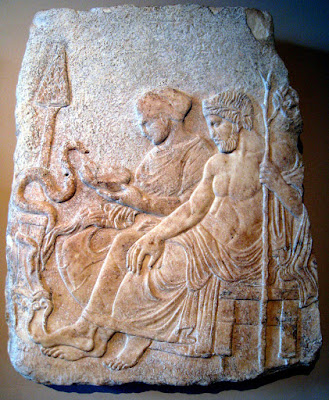he led a boy, with the beauty of a virgin girl, along the shore, a prize, or so he thought, that he had found in a deserted field. The boy seemed to stumble, heavy with wine and sleep, and could scarcely follow. I examined his clothing, appearance and rank, and I saw nothing that made me think him mortal. And I felt this and said it to my companions ‘I do not know what god is in that body, but there is a god within!
Et sensi et dixi sociis: "Quod numen in isto
corpore sit, dubito; sed corpore numen in isto est." Kline

The above image testifies to the power of the Dionysian, carried by the armies of Alexander the Great from Greece to the Ganges. (Ariadne is sitting on the god's lap.) For Ovid, the god is critical to the destiny of Thebes and, as his tale of Pentheus suggests, this fate involves the terrible consequences attendant upon the repression, or negation, of Dionysus.
We have seen the importance Nietzsche assigned to the Dionysian in his Birth of Tragedy:
Even under the influence of the narcotic draught, of which songs of all primitive men and peoples speak, or with the potent coming of spring that penetrates all nature with joy, these Dionysian emotions awake, and as they grow in intensity everything subjective vanishes into complete self-forgetfulness. In the German Middle Ages, too, singing and dancing crowds, ever increasing in number, whirled themselves from place to place under this same Dionysian impulse. . .. There are some who, from obtuseness or lack of experience, turn away from such phenomena as from "folk-diseases," with contempt or pity born of consciousness of their own "healthy-mindedness." But of course such poor wretches have no idea how corpselike and ghostly their so-called "healthy-mindedness" looks when the glowing life of the Dionysian revelers roars past them. (Walter Kaufman translation)
If we add to this terror the blissful ecstasy that wells from the innermost depths of man, indeed of nature, at this collapse of the principium individuationis, we steal a glimpse into the nature of the Dionysian, which is brought home to us most intimately by the analogy of intoxication.It may reward attention to look at how Ovid handles this polarity. Certainly there is an opposition of the proud, solitary Pentheus to the fury of the many worshippers of all ages and classes, who are so possessed that they do not even recognize the individual king whom they tear apart.
I imagine a far finer and more comprehensive task for [psychoanalysis] than alliance with an ethical fraternity. I think we must give it time to infiltrate into people from many centers, to revivify among intellectuals a feeling for symbol and myth, ever so gently to transform Christ back into the soothsaying God of the vine, which he was, and in this way absorb those ecstatic instinctual forces of Christianity for the one purpose of making the cult and the sacred myth what they once were—a drunken feast of joy where man regained the ethos and holiness of an animal. That was the beauty and purpose of classical religion.
(Quoted in Richard Wolin, The Seduction of Unreason: The Intellectual Romance with Fascism from Nietzsche to PostmodernismWhere Nietzsche writes of the terrifying bliss of Dionysus, Jung speaks of the promise of pagan myth to "ever so gently transform Christ.", 71.)

The painting has inspired various interpretations. It portrays the moment that Dionysus, leading his revelers, some of whom are carrying parts of a body, finds and falls in love with Ariadne, abandoned on the shores of Naxos by Theseus. Theseus (in the ship at left) is heading back to Athens after having threaded the labyrinth and destroyed the Minotaur with her help. Dionysus discovers Ariadne and eventually crowns her with a constellation. Some have suggested that a memory of the strong womanly world of Crete lives in this story in which the daughter of Minos is taken as bride by the god whom Pentheus finds effeminate. Ariadne is believed by some (e.g., Kerenyi) to have been the "great goddess of Crete."
you, the victor who retraced your steps, would have died
in the winding labyrinth, unless guided by the thread I gave you,
Then, you said to me: ‘I swear by the dangers overcome,
that you’ll be mine while we both shall live.’
We live, and I’m not yours, Theseus, if you still live,
I’m a woman buried by the fraud of a lying man.














